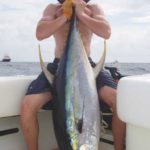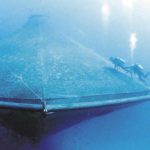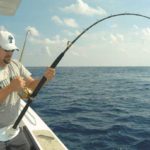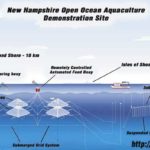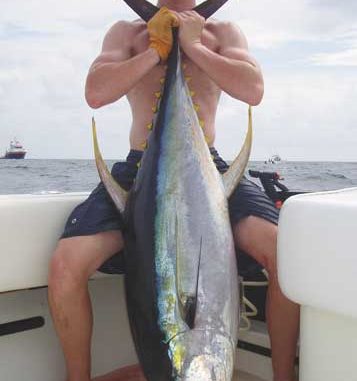
The concept of offshore aquaculture is growing in popularity as wild-fish stocks get scarcer. But will the practice cause irreparable harm to Louisiana’s game fish?
Before discussing the technical aspects of the Gulf of Mexico Fishery Management Council’s Generic Offshore Aquaculture Amendment, it may be useful to look at world fisheries trends and why offshore aquaculture is even being considered. In Outlook for Fish to 2020: Meeting Global Demand, a 2003 report by the International Food Policy Research Institute, fish culture is predicted to play a critical role in filling consumer demands for seafood. World fish harvests have grown rapidly from 40 million tons in 1973 to 65 million tons in 1997, but worldwide harvests of wild fish have now leveled off and are expected to grow only slowly to 2020.
Aquaculture has grown, making up 30 percent of global seafood production in 1997, compared to just 7 percent in 1973. Aquaculture’s share is projected to reach 41 percent by 2020.
According to the report, seafood is truly a global commodity. Roughly 40 percent of the world’s production is traded across international borders, compared to 10 percent for meat. This is astounding for such a perishable food item.
Under an economic model (International Model for Policy Analysis of Agricultural Commodities and Trade), real prices for seafood are expected to continue to rise through 2020 — 6 percent for low-value finfish, 15 percent for high-value finfish, crustaceans 16 percent, mollusks 4 percent and fishmeal and fish oil 18 percent.
Nearly one-third of the world’s wild-caught fish are caught to be processed into fishmeal and fish oil. Both are heavily used in aquaculture. In 1988, 10 percent of the world’s fishmeal was used in aquaculture feeds; by 2000, it was up to 35 percent. In spite of the increased use of fishmeal for aquaculture, harvests of fish for meal remained stable.
A European Molecular Biology Organization (EMBO) report, Fish as Food: Aquaculture’s Contribution: Ecological and Economic Impacts and Contributions of Fish Farming and Capture Fisheries, weighs in on the issue of using fishmeal for aquaculture, saying that the use of fishmeal for fish food may be its best use, since fish need less of it to grow a pound of edible flesh than farm animals on land do. Additonally, aquacultured fish generally need to eat less food for growth than do wild fish.
The EMBO report points out that fish provides about 16 percent of the animal protein consumed by the world’s human population. Consumption of food fish has increased by 115 percent from 1970 to 1998, and is expected to increase even more. The growth in consumption is primarily due to increases in human population rather than people making fish a larger percentage of their diet.
The report concludes, “There are not too few fish — there are too many people.” It adds that if agriculture had not developed for land animals, not enough food would exist for the current human population. Aquaculture development is a form of agriculture development, and if aquaculture is unfairly assigned a negative label, it could injure its development and end up causing negative effects on both wild fish stocks and human populations.
The Gulf Council’s Generic Aquaculture Amendment points out two reasons for aquaculture to be conducted offshore rather than inshore. First, there are fewer competing uses farther from shore. Second, deeper waters and stronger currents ease the environmental impacts of aquaculture, such as the addition of nutrients.
The Gulf Council’s Programatic Environmental Impact Statement has addressed many possible impacts of offshore aquaculture, including increased nutrient loading, habitat degradation, fish escapement and disease, user conflicts, economic and social impacts on domestic fisheries and navigational hazards. The preferred options in the amendment are intended to prevent or mitigate these impacts.
The amendment would require offshore aquaculture permit holders to have an assurance bond for the removal of the aquaculture structures, to keep extensive records and to have a plan for monitoring by the National Marine Fisheries Service (NMFS).
Only native species managed by NMFS could be cultured, and they could not be genetically modified. Likely species to be targeted for offshore aquaculture in the Gulf EEZ are cobia, red drum, red snapper, black seabass, mutton snapper, greater amberjack, vermillion snapper, Nassau grouper, red grouper and black grouper.
Aquaculture facilities will be limited to certain areas to protect essential fish habitat, traditional fishing grounds, hard bottom, corals and coral reefs, habitat areas of particular concern, marine reserves and important spawning and nursery habitats for marine species.
NMFS will also assess the reliability of the growing systems to be used to withstand major storms and other natural disasters. Most likely to be used are cages or net pens made up of synthetic webbing pulled over rigid frames. These may be located near offshore oil and gas platforms, which may be used for housing, maintenance and storage. The space beneath the platform could possibly be used to culture coral and live rock for the aquarium trade and sponges for pharmaceutical uses.
Typically, the floating net pens or cages would be anchored to the water bottom and lowered deep underwater to avoid damage from hurricanes and storms, vandalism or the routine effects of wind and waves.
A Hubbs-Seaworld Research Institute net pen moored 25 miles off of Virginia’s coast in 1996 withstood two hurricanes. A NOAA buoy less than one mile away recorded 45-foot seas and winds over 90 m.p.h.
The Generic Aquaculture Amendment provides for regulation by numerous federal agencies besides NMFS.
“The U.S. Army Corps of Engineers will require a Section 10 Permit for the creation of any obstruction to navigation.
“The Environmental Protection Agency, under the Clean Water Act, will require a point-source discharge permit.
“The U.S. Fish and Wildlife Service, under the authority of the Fish and Wildlife Coordination Act, the Endangered Species Act, The Migratory Bird Act and the Marine Mammals Protection Act, will review and comment on any activities.
“The U.S. Department of Interior’s Minerals Management Service may review and comment on aquaculture permits under the Outer Continental Shelf Lands Act.
“The U.S. Food and Drug Administration regulates any therapeutic agents, including antibiotics, that are to be used in treating fish diseases.
“The U.S. Coast Guard will require all aquaculture-related structures to be marked with lights and signals to ensure safe navigation.”
Issues and answers
Nutrient pollution from fish farms resulting from food waste and feces is a concern. Fish produce both feces and soluble nitrogenous wastes as they grow. They are identical to those produced by wild fish and are typically recycled as nutrients within the marine food chain. Some uneaten feed will appear in the waste stream, but the amount is unlikely to be large. Fish feeds are a major cost of operation, and not likely to be wasted.
The issue is when an excess of these wastes are allowed to build up in a localized area faster than the natural food chain can recycle them. To prevent nutrient problems, aquaculture facilities should be spread out and located in areas with enough depth and current to prevent nutrient overloading of an area.
A report prepared for the National Oceanic and Atmospheric Administration and the National Sea Grant College Program in 2007 by the consultants Rensel Associates Aquatic Sciences and Forster Consulting addresses nutrient overloading as well as other issues in salmon culture.
The executive summary of the report includes the following statement: “The popular media-distributed notion of fish farming habitats often suggests a biological wasteland, heavily impacted by fish feces, waste feed, antibiotics and chemicals. Nothing could be further from the truth for Washington State fish farms (and those in the State of Maine). Antibiotics are rarely used (vaccines are used instead), no sea lice problems exist due to naturally reduced salinity levels, and farm siting involves locations with fast currents or relatively great depth that distribute wastes over large areas where they may be incorporated into the food web while maintaining aerobic surficial sea bottom sediments.”
“Genetic pollution” caused by escaped farmed fish interbreeding with wild fish is predicted by many to reduce the ability of the hybrids to survive in the wild. Certainly, whenever fish have been farmed, some have escaped. The issue is how many escapees there will be in relation to wild fish numbers.
For some very small salmon runs of only a few thousand fish, the release of thousands of farmed fish could conceivably have a major genetic impact. But the release of a few thousand fish into a natural population of millions is less concerning.
Also, as a matter of logic, the supposedly poor survivability of farmed fish will likely reduce their chances to survive long enough to breed in the first place. No transgenically modified fish may be cultured under the provisions of the amendment.
The use of fishmeal to feed fish has caused concern in some people over the possible overfishing of forage species, such as menhaden. This seems to be a logical fear, until numbers are considered. Fishmeal is expensive, and increased prices are more likely to reduce its use than to expand the harvest of industrial fish. The percentage of the globe’s fishmeal supply used in aquaculture increased from 10 percent in 1988 to 35 percent in 2000. Yet global harvests of fish for meal have remained stable during that period.
Using fishmeal to feed fish rather than other animals may also be the most efficient use for the resource. Generally speaking, fish convert feed to edible protein far more efficiently than land animals do, including even chickens. In other words, it takes less fishmeal to produce a pound of fish than it does to produce a pound of meat.
Some researchers have also shown that the conversion of baitfish into fishmeal and then into farmed fish may be up to five times more efficient than if the same baitfish were left as forage for wild fish in natural fisheries. This is due to the flow of energy in natural food webs and to the higher survivability of juvenile cultured fish over their wild counterparts.
Antibiotics used in fish are feared as likely to cause resistance in micro-organisms when the antibiotics get into the wild. However, far fewer antibiotics are allowed by the U.S. Food and Drug Administration for use in aquaculture than for land animal agriculture. When antibiotics are used in aquaculture, it is more efficient to vaccinate the individual fish than to apply them loosely.
The spread of diseases from crowded fish-farm operations to wild fish is often cited as a danger. Real life experience in cage aquaculture elsewhere in the world has shown that the reverse situation is more often true. Good cultural practices, including sensible stocking densities and constant monitoring, are necessary to prevent losses of stock to diseases.
Price reductions for traditional commercial fishermen may be a likely consequence if large amounts of farmed fish are produced and marketed. Experience in catfish, shrimp and salmon have shown this to be true. Aquacultured fish also may taste differently, some say inferior, to their wild counterparts. This may allow wild fisheries producers and marketers some ability to counteract price reductions to a certain degree.
The issues surrounding the development of offshore aquaculture are not simple and its development may be constrained more by economics than anything else, according to Greg Lutz, professor and aquaculture specialist with the LSU AgCenter/Sea Grant Program.
“Whether we like it or not, for most consumers, the price they have to pay for fish is the bottom line,” he said. “And producers can grow fish in the tropics more efficiently than we can.
“A perfect example is red drum. Redfish fillets from Taiwan and elsewhere in Southeast Asia can be imported to Louisiana cheaper than we can produce whole fish, even before the loss of filleting, in the Gulf. I don’t mean to sound negative, but the numbers are the reality.”
Lutz goes on to explain that some things may be done to make our aquaculture operations more efficient. For example, some species may be bred to be able to adapt to lower protein diets or diets derived from plant foods, which are less expensive than fishmeal-based feeds. Culture systems may also be improved.
“The carbon footprint of transportation must be factored in as well,” says Lutz. “Carbon costs equal money. While Chinese redfish have to be transported around the globe, the costs of transporting feed and supplies to and from U.S. fish farms far offshore must be considered. What the current potential for offshore aquaculture is in this country is really not well-defined.”
Lutz also had comments about the current debate over the Generic Aquaculture Amendment.
“We encounter this prejudice against all things aquacultured often, when in fact there are many things about aquaculture that are sustainable,” he said. “The mindset against aquaculture completely discounts the fact that its overall impacts are benign compared to most human activities, including other food production activities.
“Many misconceptions exist, and just as important as the misconceptions is the lack of perspective. Look at traditional agriculture. It is far removed from the pristine wilderness state that once existed. But it has gone on so long that we accept it as normal now.”
He noted that a number of motivations exist for the unyielding opposition to aquaculture.
“Some people have something to gain or lose if this develops,” he said. “Others use this to promote themselves or their causes by conjuring up demons that they are protecting society from. And, unfortunately, there are lots of people who enjoy being followers without having to engage in critical thinking about an issue.”
Lutz encourages people who have something at stake to examine this or any issue thoroughly and study the science. Doing so allows each person to make an informed decision, rather than just to react in fear to what they have heard others say.
The Gulf Council staff has prepared revisions to the Generic Aquaculture Amendment based on public comment. Final action on the amendment could take place at the Council’s June 2-5 meeting, but is more likely to occur at the Aug. 11-14 meeting.
